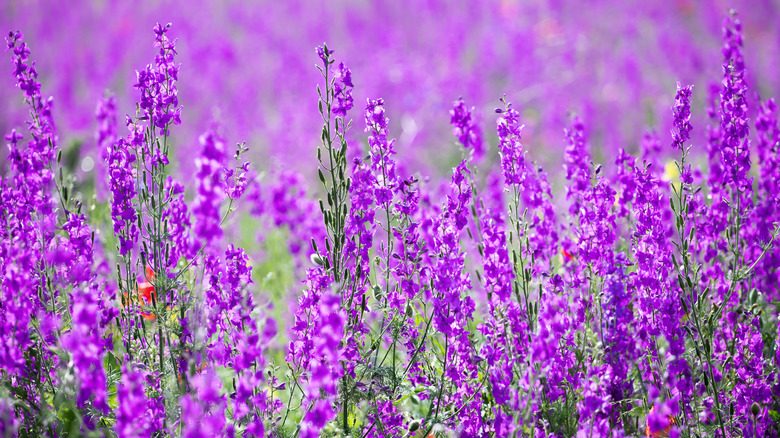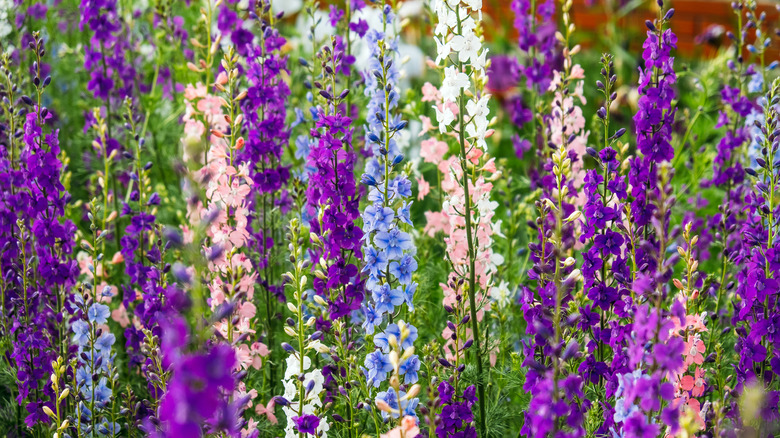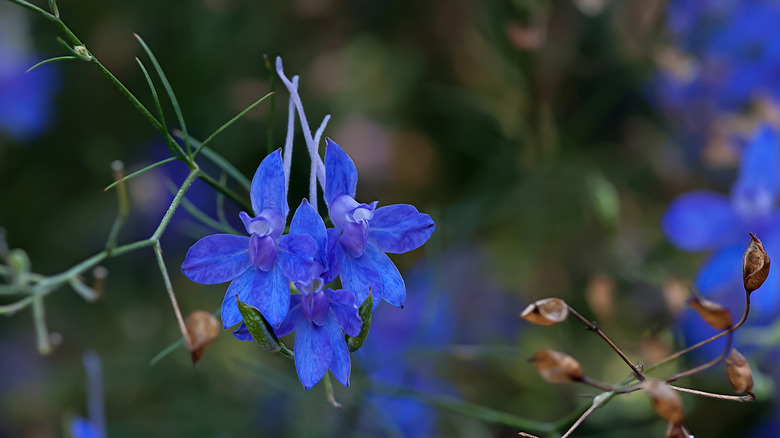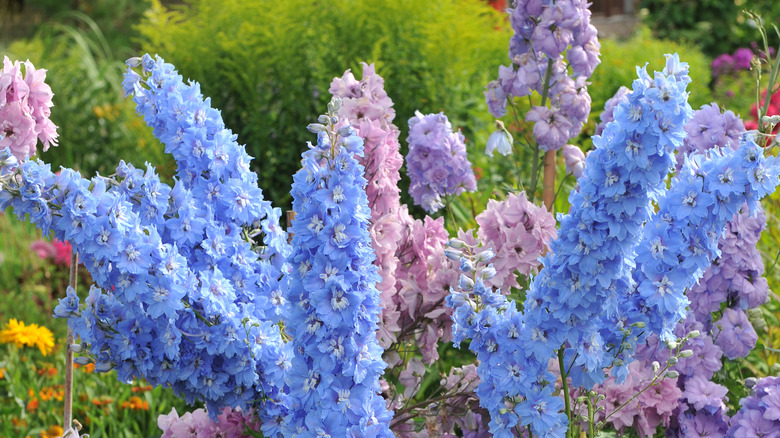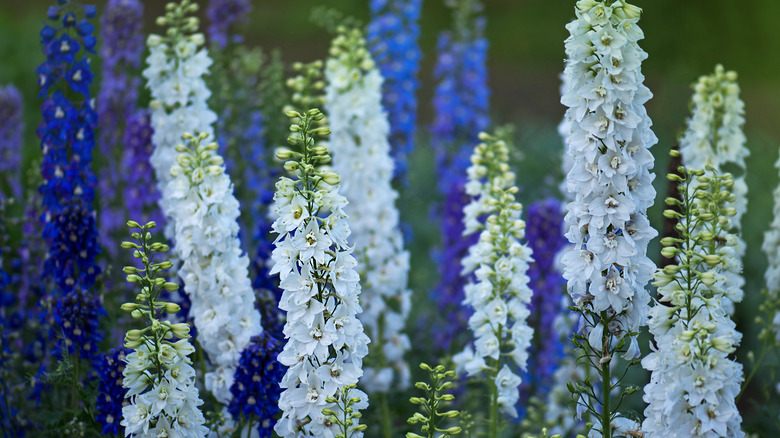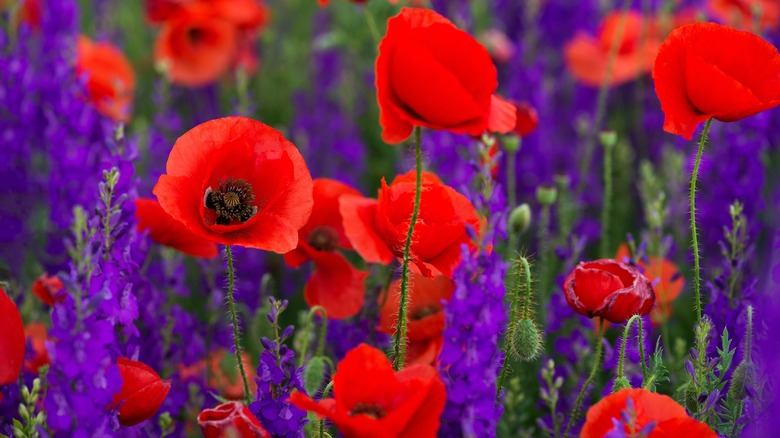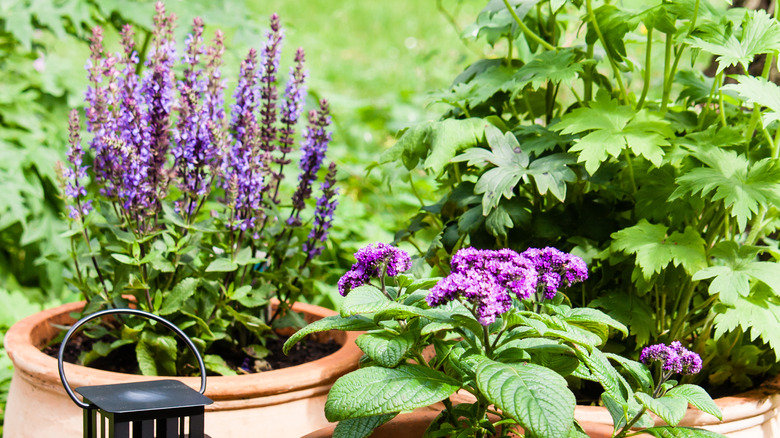How To Successfully Grow Larkspur
Larkspur (scientific name: delphinium consolida) is a plant full of feline duality. Often referred to as delphinium, they can bring pleasure to the eye, and punishment to those who get too close. They are poisonous, so keeping children and pets away from larkspur is essential.
Larkspur is a perennial in the Ranunculaceae (or buttercup) family, and its flowers are considered by experts to be nearly as complex as orchids. Because they bloom in the spring, they're often used to provide the first evidence of the approaching warmer days ahead. They're also the birth flower of those born in July, and attract butterflies and hummingbirds to your garden. People make presents of larkspur, too — for different reasons. Consult Petal Republic, and you'll find that each color transmits a different message, at least historically. For example, white larkspur flowers represent joy and happiness and are often used to convey an air of innocence. They're also used to signify fresh starts and new adventures. Conversely, our predecessors considered pink larkspur a nod to sudden change and indecision. In flowerspeak, pink larkspur is also linked to love and affection, and is intended to communicate attraction and approval. Furthermore, respectability and grace are imparted by blue larkspur, while purple larkspur signifies first loves and social standing.
Finally, larkspur appears in several mythological tales. At Florgeous, contributors have found references to larkspur in both ancient Greek literature and more recent Native American folklore.
How to use larkspur in garden
Larkspur flowers are comprised of four small petals, a solitary pistil, and stamens with anthers tinted light blue. They appear in an assortment of colors ranging from purple and blue to red, pink, and white. Among the other plants in your garden, larkspur provides an effect similar to ferns and pairs well with an assortment of companions, as noted by Better Homes & Gardens.
As perennials, larkspur plants have long been a part of classic cottage gardens. They also make a terrific option to grow along a flower border, particularly at the back, although staking them is routinely necessary. Should you prefer something easier to maintain, The Spruce recommends checking out the varieties of dwarf types available. On the other hand, tall larkspur varieties can reach heights of 7 feet and provide an impressive splash of color — if you don't mind the upkeep. Speaking of which, larkspur has a reputation as short-lived, but how they're cared for can make a dramatic difference in their longevity, since their natural enemies of crown rot and botrytis blight can be ameliorated by attentive gardening. Guarding against such disease means keeping your garden clutter-free, providing adequate spacing for the plants to grow and mulching.
How to grow larkspur
According to the florists at Truly, the seeds that yield larkspur can be fairly finicky to start. They require cold temperatures before they're sown, so you'll want to refrigerate your seeds for about two weeks before planting. Larkspur can also be moved and transplanted, but use abundant care, because the taproots responsible for the flowers' growth are delicate and easily damaged.
Understanding seed germination helps. If you follow the guidance provided by gardeners at Gardening Know How, you'll refrigerate your seeds for 14 days in a plastic bag and add some damp perlite to keep the seeds moist. You could also pot the seeds, so long as you have a place to store them where the temperatures don't vary much and remain consistently between 40 and 50 degrees Fahrenheit. Larkspur will not germinate above temperatures of 65.
There's also some weather forecasting involved for the best outcome: You should have some notion about when the first frost occurs. That's because the seeds need to be planted far enough in advance of that frost to be able to generate the roots that will keep the plants alive through the winter months. Because they're so delicate at this stage, it's best to plant them in what will be their permanent home. Experienced florists say that larkspur can be planted in the spring, although the flowers will be unlikely to attain the potential of those planted earlier.
How to care for larkspur
The good news is that once you've shown your larkspur the kind of care and attention to detail it requires, the flowers are relatively easy to maintain. The advisors at Better Homes & Gardens consider larkspur plants fairly hearty — once they've reached maturity.
The experts do say that for the best results, gardeners should seek out and maintain soil that's well-draining. Larkspur is not a fan of being drenched or kept extremely wet for extended periods. On the other hand, you'll also want to make sure your flowers have regular access to moisture. One way to tell if they're not getting enough water is when you see they've not reached complete growth or the buds appear dry or stunted.
Lastly, larkspurs love the sun. They can cope with a small amount of shade, but for the best results, plant them where they can have a decent amount of sun exposure and either use stakes, place them near a structure or wall, or plant them densely.
Varieties of larkspur
Per the USDA, larkspurs generally fall into three categories: tall larkspurs (D. barbeyi, D. occidentale, D. barbeyi), low larkspurs (commonly known as D. nelsonii), and plains larkspurs (D. geyeri). These terms derive from where the flowers are found in nature, or their height at maturity.
Tall larkspurs are recognized by their spurred blue flowers, and because they're reminiscent of garden delphiniums, with wide leaves separated into lobes. The tall varieties are perennials found in meadows and on hills, and their height often ranges from 1 to 2 meters. Low larkspurs sprout blue blooms that grow near the top third of an unbranched stem. They're often spotted in sagebrush areas and on hills where the flowers occasionally reach as high as 2 feet.
Beyond that, Britannica estimates that there are close to 365 varieties. The most popular include:
- Black Knight (Delphinium Elatum) derives its name from its shade and semi-double flowers. Generally a summer bloomer, they can sometimes flower again early in the fall.
- Galahad (Delphinium Galahad) is a candle larkspur known by two properties: a longer lifespan, and its snow white flowers, which starkly contrast against the plant's green leaves.
- Astolat (Delphinium Astolat) is a Pacific Giant larkspur hybrid, distinguished by pink or lavender-pink semi-double blossoms. They reach peak blooms early- to mid-summer.
- Dwarf Larkspur (Delphinium Tricorne) are 1 to 2 feet high — too short to require stakes. The colors range from blue to violet and purple. They'll bloom in April and May — early for most larkspurs.
Is larkspur toxic?
Since larkspur is often found in the wild where cattle graze, ranchers are constantly on the lookout for its appearance in pastures. Just the same, there are significant losses of cattle every year because the animals are drawn to the flowers as edible, when in fact they can quickly attack the nervous system and have proven to be deadly. Occasionally, the plant is responsible for an annual herd mortality of as much as 10%, as noted by Science Direct.
That being said, larkspur rarely causes death in humans because of the amount required to become lethal. Still, as you might expect, human consumption of any part of larkspur is highly discouraged, although the most toxic component may actually be the plant seeds themselves. Advisors at The Day suggest that thorough hand-washing is the best remedy for touching the plant or its flowers. You also should keep pets like dogs, cats, and horses away from larkspur.
How to repot lakspur
Besides being toxic, larkspur is cranky when it comes to moving; the plants don't like it much. But if you ask around, as one inquisitive gardener did on Flower Shop Network, you'll find that the process itself is fairly straightforward.
You can use an all-purpose potting soil, for a start. But make certain the new receptacle is a container with holes to provide drainage. And it's important to keep in mind that no matter what you're repotting, place your plant at the same level above the soil as it was in its former home, because that's vital for root development. Immediately after the procedure, be sure to water your plant, and repeat that whenever you notice the soil leaning toward dry. You can add a light solution of plant fertilizer two weeks later.
If you don't already know, it would be wise to research the variety of larkspur you're growing, to find out if it's is annual, biennial, or perennial. Biennials or perennials prefer to live outdoors — although you'll want to make sure the climate where you live is going to help it thrive.
